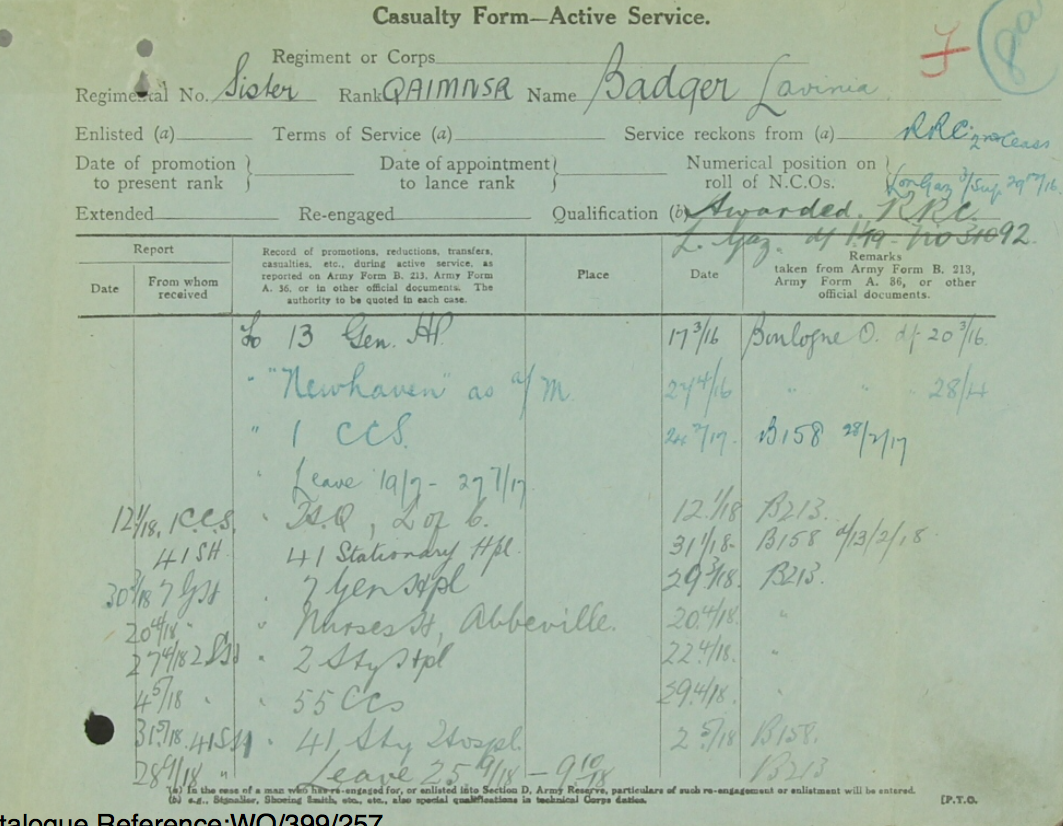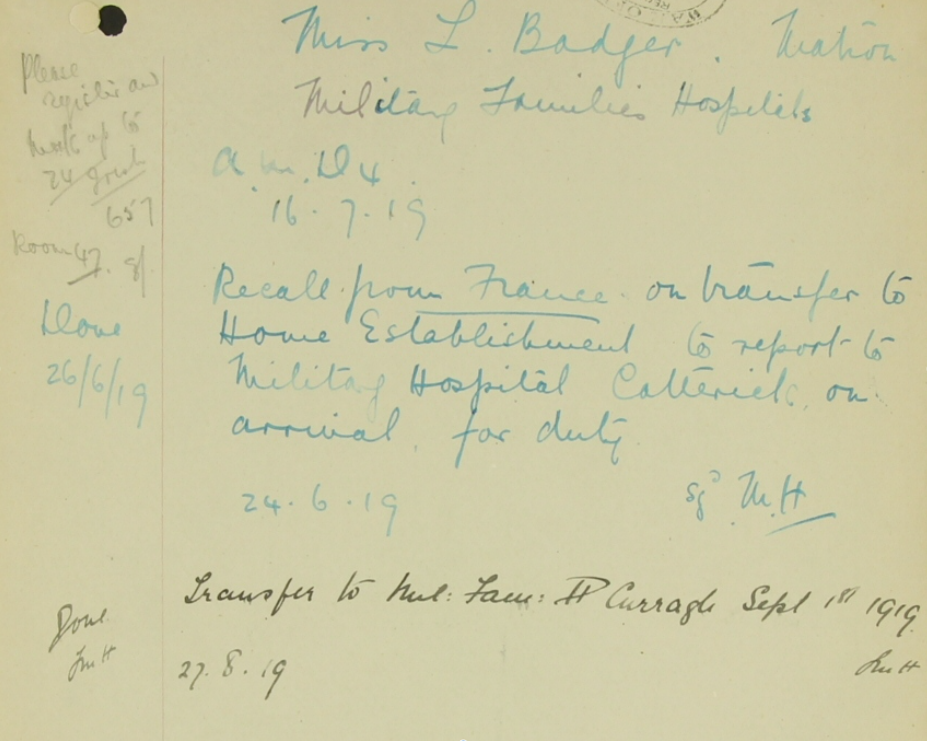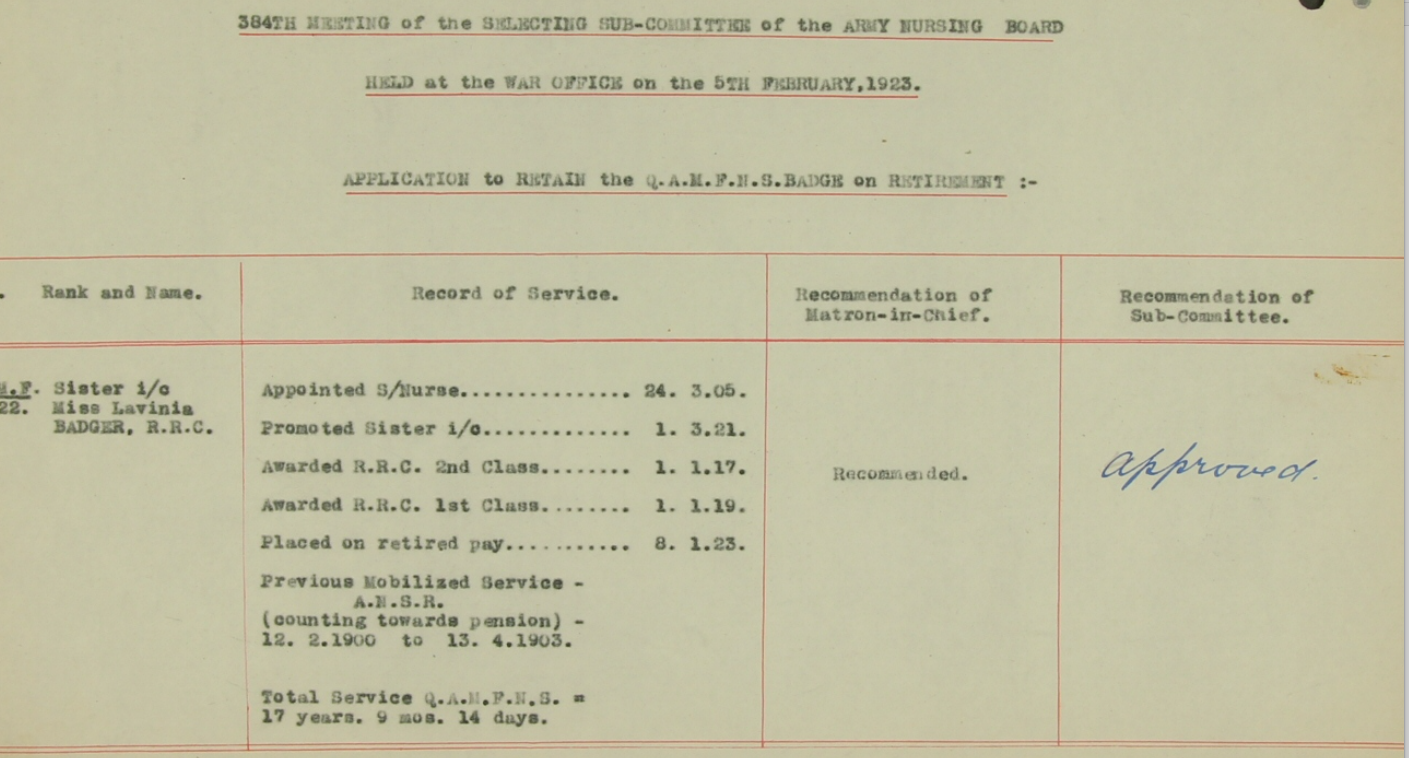WO 399 collection
Context
The main source for information about nurses in WW1 is the personnel files held at TNA, Kew. Some of the records contain application forms to join the Queen Alexandra's Imperial Military Nursing Service or Reserve, which indicate previous service. These forms helped with the research on Nurses in the Boer War. The content and size of the records vary enormously. Things you might find include:
- where a nurse trained or worked before the war
- references relating to their suitability as military nurses
- hospitals, field ambulances, casualty clearing stations, ships or other units they served in
- what their superiors thought of them (confidential reports)
- when they left the services
Lavinia Badger RRC QAIMNS/ QAMFNS
We are going to use Lavinia Badger as an example of a nurse who served in WW1, and what her WO 399 record can tell us.
The records are often messy and hard to read, and surprisingly they are not always in chronological order. We find it best to go through and note the things that you want to use, and their date, and then put your own notes into chronological order. The records were weeded at some point and so they may not be as complete as would would like. Not every nurse who served in WW1 has a surviving record but most do.
Casualty Form - Active Service
Most records have a Casualty Form - Active Service in them. These are not about being a casualty despite their name, they list a person's movements during the war. This is the first page of Lavinia Badger's:
You can see that this gives her rank, and also the awards of the Associate Royal Red Cross (or RRC 2nd Class), and the Royal Red Cross (or RRC 1st Class) and the dates these were published in the London Gazette. You will come across references to the London Gazette as LG, L Gazette and Gazette. This publication is the official publication of the Government and is where you will find all honours and awards to military nurses.
You can see it also lists some of her postings (they continue onto page 2). You can see how an understanding of Army abbreviations is important to get the most out of any of these types of records.Looking at this page I can see:
- She was sent to join the BEF in France, joining 13 General Hospital, Boulogne on 19th March 1916.
- She then joined the Hospital Ship Newhaven as Acting Matron on 27th April 1917.
- She was then posted to No. 1 Casualty Clearing Station on 24th February 1917.
- She was then posted to No. 41 Stationary Hospital on 31st January 1918.
- She was then posted to No. 7 General Hospital on 29th March 1918.
- She was then posted to (I don't think admitted to) the Nurses Hospital, Abbeville on the 20th April 1918.
- She returned to No. 41 Stationary Hospital on 2nd May 1918.
This looks like a lot of rapid postings. From the Matron-in-Chief's diary we can see how she moved people around to make sure she had the right skill mix and also in response to the different campaigns and battles.
Postings
Sometimes postings, and the reason for them, for annotated in the record. For example:
Here we can see her being recalled from France to report to the Military Hospital, Catterick and then her transfer to the Military Families Hospital Curragh.
Occurrences
Some very specific occurrences were also noted in the records, for example, honour and awards. In this case there is official notification of the seriousness of Lavinia Badger's illness when she caught influenza in 1918. The Army has a system where patients are 'listed' as 'Seriously Ill' (SIL) or 'Very Seriously Ill' (VSIL). These patients are then notified to the War Office (or the MOD today) and regular updates given. In this example she has been removed from the Seriously Ill List:
Confidential Reports
Some of the records contain confidential reports. These were written at least once a year, and also if a nurse was being considered for promotion. There was a standard format, although during the war they were often much more informal in their structure. Lavinia Badger has two in her record, and an extract of one is shown below:
Sumaries
Sometimes we are lucky that there are summaries of service. This is most often to do with calculating pay and allowances once service comes to an end. As Lavinia Badger had served as an Army nurse for over 22 years she was considered for the retention of her 'tippet medal' which nurses would normally have returned when they left the service. The committee required a summary of service for their consideration and this is shown here:
Summary
Taking the information from a WO 399 record and joining it with information from other sources like the London Gazette, the Census, and family records allows us to build quite a full picture of the career of a single nurse. Once we start to do this for a few nurses (as we are on the britisharmynurses.com site) we can start to see patterns emerging which can give us a greater insight into the nursing service as a whole.





